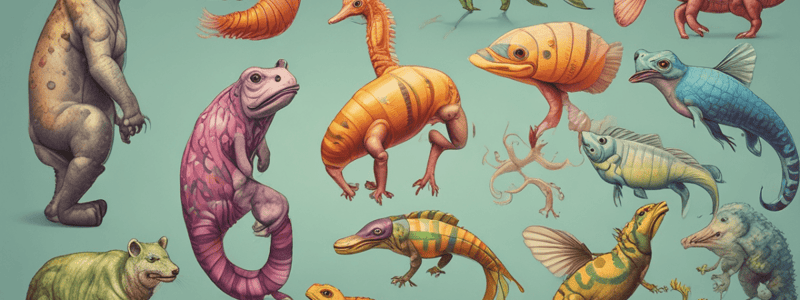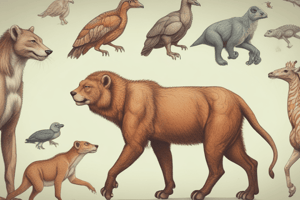Podcast
Questions and Answers
What are the two major groups of protostomes?
What are the two major groups of protostomes?
- Lophotrochozoa and Ecdysozoa (correct)
- Arthropoda and Nematoda
- Chordata and Echinodermata
- Mollusca and Annelida
In which habitats are flatworms found?
In which habitats are flatworms found?
- Only in marine environments
- In freshwater, marine, and moist terrestrial environments (correct)
- Only in freshwater environments
- Only in moist terrestrial environments
What happens to tapeworm embryos once they are released from the proglottid?
What happens to tapeworm embryos once they are released from the proglottid?
- They are ingested by the host
- They attach to the host's intestinal wall
- They develop into new tapeworms
- They are scattered in the environment (correct)
What is the basic body plan of a mollusk?
What is the basic body plan of a mollusk?
What is the defining characteristic of the Deuterostomia clade?
What is the defining characteristic of the Deuterostomia clade?
What type of environment do members of the phylum Rotifera typically inhabit?
What type of environment do members of the phylum Rotifera typically inhabit?
Which of the following is a characteristic of the class Chelicerata?
Which of the following is a characteristic of the class Chelicerata?
What organisms are included in the class Myriapoda?
What organisms are included in the class Myriapoda?
What role do arthropods play?
What role do arthropods play?
Which of the following accurately describes chelicerates?
Which of the following accurately describes chelicerates?
What class includes insects?
What class includes insects?
What is the defining characteristic of the class Chelicerata?
What is the defining characteristic of the class Chelicerata?
What is the process by which gastropod mollusks undergo during larval life?
What is the process by which gastropod mollusks undergo during larval life?
Which of the following accurately describes the function of the mantle in mollusks?
Which of the following accurately describes the function of the mantle in mollusks?
Which of the following accurately describes the circulatory system of annelids?
Which of the following accurately describes the circulatory system of annelids?
What is the unique, protrusible, tongue-like organ used for feeding in mollusks called?
What is the unique, protrusible, tongue-like organ used for feeding in mollusks called?
Which of the following accurately describes a major advantage of segmentation in annelids?
Which of the following accurately describes a major advantage of segmentation in annelids?
Which class of animals are commonly known as chitons?
Which class of animals are commonly known as chitons?
What is the unique structure of a lophophore in brachiopods?
What is the unique structure of a lophophore in brachiopods?
How do tapeworm embryos exit the proglottid once released?
How do tapeworm embryos exit the proglottid once released?
Which phylum includes vinegar eels, eelworms, and other roundworms?
Which phylum includes vinegar eels, eelworms, and other roundworms?
What is a characteristic habitat for members of the phylum Rotifera?
What is a characteristic habitat for members of the phylum Rotifera?
What is a notable feature of platyzoans regarding their feeding?
What is a notable feature of platyzoans regarding their feeding?
In mollusks, what is the function of the mantle?
In mollusks, what is the function of the mantle?
Which of the following phyla is characterized by a lophophore, a circular or U-shaped ridge around the mouth with ciliated tentacles?
Which of the following phyla is characterized by a lophophore, a circular or U-shaped ridge around the mouth with ciliated tentacles?
Which of the following features is NOT associated with the phylum Mollusca?
Which of the following features is NOT associated with the phylum Mollusca?
Which of the following phyla is classified under the clade Lophotrochozoa?
Which of the following phyla is classified under the clade Lophotrochozoa?
Which of the following accurately describes the life cycle of tapeworms?
Which of the following accurately describes the life cycle of tapeworms?
Which of the following accurately describes the phylum Platyzoa?
Which of the following accurately describes the phylum Platyzoa?
Which of the following features is characteristic of rotifers?
Which of the following features is characteristic of rotifers?
Which of the following statements about tapeworms is correct?
Which of the following statements about tapeworms is correct?
Which of the following statements about rotifers is correct?
Which of the following statements about rotifers is correct?
Which of the following statements about platyzoans is correct?
Which of the following statements about platyzoans is correct?
Which of the following is a distinguishing characteristic of mollusks?
Which of the following is a distinguishing characteristic of mollusks?
Which of the following is a characteristic of lophotrochozoans?
Which of the following is a characteristic of lophotrochozoans?
Which of the following statements about the phylum Mollusca is correct?
Which of the following statements about the phylum Mollusca is correct?
Flashcards are hidden until you start studying
Study Notes
Bilaterian Animals
- Almost all bilaterian animals belong to either of the clades Protostomia and Deuterostomia.
Protostomia
- The two major groups of protostome are Lophotrochozoa and Ecdysozoa.
- Lophotrochozoa includes mollusks, annelids, and platyhelminthes.
- Ecdysozoa includes arthropods and nematodes.
Flatworms
- Flatworms are found in aquatic and in moist terrestrial environments.
Tapeworms
- Immediately after release from the proglottid, tapeworm embryos are scattered in the environment.
Rotifera
- Rotifera are tiny, bilaterally symmetrical pseudocoelomates that often live in freshwater environments.
- They use adhesive toes for clinging on vegetation and other solid objects.
Deuterostomia
- In deuterostomes, the blastopore gives rise to the anus.
Mollusca
- Squid, octopuses, chitons, snails, clams, and oysters are all members of the phylum Mollusca.
- The basic body plan of a mollusk consists of three parts: a muscular foot, a visceral mass, and a mantle.
- The mantle of a mollusk is an epidermal sheet covering the dorsal side of the body.
- The shell of a mollusk is secreted by the outer surface of its mantle.
- The muscular foot of a mollusk may be adapted for locomotion, attachment, food capture, or digging.
Annelida
- Annelids are segmented worms, with a body built of repeated units.
- Each segment of an annelid contains a ganglion, excretory organs, and locomotory structures.
- Annelids have a closed circulatory system.
Lophotrochozoa
- Lophotrochozoa includes phyla such as Bryozoa, Brachiopoda, Phoronida, and Micrognathozoa.
- Bryozoans are small and live in colonies, and have a lophophore.
- Brachiopods or lamp shells have two calcified shells, and their anus opens near their mouth.
Ecdysozoa
- Ecdysozoa includes phyla such as Arthropoda, Nematoda, and Tardigrada.
- Arthropods have a role in the pollination of crops, the destruction of crops, and the spreading of serious diseases.
- The class Hexapoda includes insects.
- The class Myriapoda includes centipedes and millipedes.
- The class Chelicerata includes organisms with mouthparts modified as pincers or fangs, and bodies consisting of two tagmata.
Other Phyla
- Platyhelminthes are flatworms with a body plan that resembles a flatworm.
- Rotifera are tiny, bilaterally symmetrical pseudocoelomates.
- Micrognathozoa have a complete gut and are pseudocoelomate.
Studying That Suits You
Use AI to generate personalized quizzes and flashcards to suit your learning preferences.




